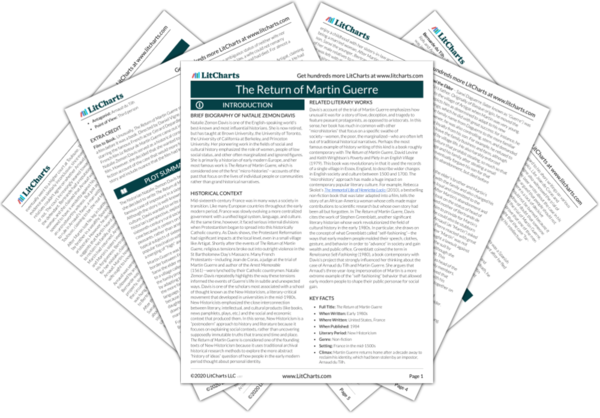In sixteenth-century French peasant communities, the villagers frequently hosted carnivals in which people could dress up as others using costumes and masks, taking on other identities—even just for an evening. In Davis’s reading, the mask evokes many forms of impersonation in Renaissance culture, suggesting that everyone is always impersonating someone or something else. The mask, in other words, symbolizes the fact that identity is always, in some sense, a charade. For instance, the Daguerre family “masked” their identity by changing their name to “Guerre” when they arrived in Artigat in order to better assimilate to their new community. Likewise, healthy beggars sometimes pretended to be disabled or blind in hopes of appealing to people’s charitable impulses. Furthermore, Davis describes Arnaud du Tilh as “rehearsing” for the role of Martin Guerre, underscoring the theatrical dimensions of his deception. Arnaud essentially wore the “mask” of Martin, like a player in a carnival. But Davis suggests that this impersonation was merely an extreme example of the performances in which many people engaged when they took on new personas, like the Daguerres who became the Guerres. The carnival mask is such a resonant symbol for Davis because it shows that everyone masks their identity in one way or another.
The Carnival Mask Quotes in The Return of Martin Guerre
Was it so unusual for a man in sixteenth-century villages and burgs to change his name and fashion a new identity? Some of this went on all the time. The Daguerres left Hendaye, became the Guerres, and changed their ways. Every peasant who migrated any distance might be expected to do the same…At carnival time and at other feastdays, a young peasant might dress as an animal or a person of another estate or sex and speak through that disguise.

Unlock explanations and citation info for this and every other The Return of Martin Guerre quote.
Plus so much more...
Get LitCharts A+Lawyers, royal officers, and would-be courtiers knew all about self-fashioning—to use Stephen Greenblatt’s term—about the molding of speech, manners, gesture, and conversation that helped them to advance, as did any newcomer to high position in the sixteenth century. Where does self-fashioning stop and lying begin?
Montaigne insists how difficult it is to know the truth about things and how uncertain an instrument is human reason. “Truth and falsehood have both alike countenances…Wee beholde them with one same eye.”
The story of Martin Guerre is told and retold because it reminds us that astonishing things are possible. Even for the historian who has deciphered it, it retains a stubborn vitality. I think I have uncovered the true face of the past—or has Pansette done it once again?












